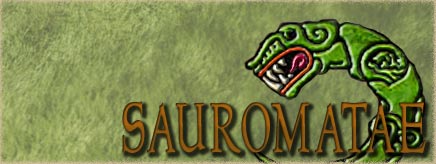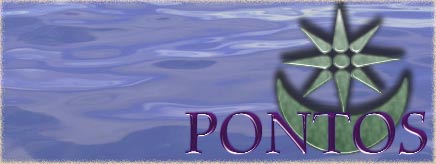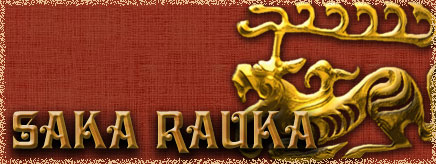Province Thessalia
History
Thessalia is where the first Hellenes (probably not calling themselves that at the time) settled in what was to be the land that took their name. It was previously inhabited by pre-Hellenic, probably non Indo-European people collectively known as Pelasgians. The Hellenes came from the North, from an area in the Pontic steppes in modern day Ukraine and/or near the Caucasus. While for a long time the widely accepted theory was that they came overland through the mountains of Aimos, it is now considered possible that the influx of settlers came by sea from the Caucasus, near what was later going to be Colchis. Ironically, a mythical Hellen king from the city of Iolkos in Thessalia, would go through great toil to complete the trip in the opposite direction in search of the Golden Fleece.
The settlers expanded more and more over the newfound land and eventually took over most of the coastal areas from Thessaly to the western coast of the Peloponnesus and the islands off it. They also dominated most of the fortifiable positions and hills. Their Sky-Thunder god (not yet personified as Zeus) took preeminence over the dominant deity of about 20000 years, the Great Mother of fertility and earth and nature, a turn in religion reflected even now in mythology. The sons of Zeus and the thunderer himself have been vanquishing chthonic monsters ever since. Still, evidence of coexistence and mutual influence between the newcomers and the Pelasgians are quite common. The northern border of Thessalia was mount Olympus, a pelasgian word simply meaning mountain, found also further south, in the Peloponnesus and even across the Aegean. In the center of the Thessalian plain was Larissa, also of pelasgian origin meaning acropolis or fortress or even, in a simpler version, just hill.
The Hellenic tribes of note that were prominent in Thessalia were the Aeolians, the Boeotians and the Aenianians, but there were others. Each tribe carved a territory in the great Thessalian plain to hold as its own. Tellingly there was such a territory called Pelasgiotis. The Hellenic tribes spoke the Aeolian dialect and spread to the islands of the northern Aegean and even across the sea to northern Asia Minor (perhaps before settling in Thessalia). The Boeotians spread to Boeotia and gave it its name.
Mycenaean era
In the southern part of Thessalia there was an area called Phthoia and in its vicinity a city called Hellas. The exact location of the city has not been designated beyond doubt, but its name has been adopted by a whole people and a whole country. Southern Thessalia was the home of Achilles and his Myrmidons, but the inhabitants of Phthoia and Achilles’ soldiers are referred to by different ethnonyms in the Iliad and are led by another king. Achilles’ father Pyleas however is said to have held sway over both regions. To the north Iolkos prospered as an important trading port of the wider region, at that time called Aeolis, maintaining trade routes to the Euxeinos Pontos importing gold among other commodities, hence the fleece of the Argonauts. Sheep’s skin was a handy “tool” for collecting gold from rivers in Colchis at that time. Though not comprehensively under single leadership, Thessalia is doted by Mycenaean palaces and Linear B inscription findings, which leaves no doubt as to whether or not this area was part of the Hellenic world. In fact, in some ways it is perhaps its birthplace.
During the eleventh century BC, following the Mycenaean decline, a Dorian tribe called Thessaloi from Thesprotia to the west, moved into the plain and settled there. Perhaps they forcibly displaced the other tribes or simply found a place among them, gradually gaining prominence enough for the land to be called after them… Thessalia!
Archaic period.
During the archaic period the tribes of Thessalia attained regional supremacy. They were self-sufficient, possessed excellent cavalry and perhaps even quite a bit wealth. To this end it is possibly very important that they were involved in many conflicts of the time in their periphery including the war between Chalcis and Eretria in Euboea. The war was largely decided in the Battle of the Lelantion Plain during which the charge of Thessalian heavy cavalry under Cleomachos of Pharsalus successively swept the enemy cavalry and hoplite phalanx. Chalcis won the day and the war, but both sides had suffered such destruction during the war that they were unable to maintain their naval and trade supremacy in the Mediterranean leaving room for Athens, Megara and Korinthos to fill the gap and their coffers. The Thessaloi were free to focus on consolidation.
Eleven polities and tribes from all Hellas rallied behind the Thessaloi in founding the Delphic Amphictyony. The institution’s purpose was initially to protect the sacred ground of Apollo in Delphoi and Demeter near Thermopylae. Gradually the Thessaloi controlled five of the eleven other tribes and were thus able to dominate the amphictyonic council since it relied on a simple voting system to reach decisions. Powerful cities such as Sparta and Athens also took part in the council, but commanded only one vote each. Besides, they were physically quite removed from the area the council convened to administer and consequently took a cooler view of things for a long time; at least until their sphere of influence reached that far. The Thessaloi, with their position in the plain consolidated, were looking for the right time and opportunity to dominate Phocaea and take control of the Delphic temple complex and oracle, along with all its wealth. They succeeded in doing both after a war that lasted about a decade. It was called the 1st Holy War.
1st Holy War (approx. 595-585)
The cities of Kirra and Krissa its port were the only ones in Phocaea that had not been subdued by the Thessaloi. Perhaps in need of money to withstand the pressure from their northern neighbors, their inhabitants harassed the pilgrims to Delphoi and also engaged in piracy in the Corinthian bay, which meant they were a big problem for the city of Sicyon. Krissa was the closest port to the oracle so anyone travelling by boat to Delphoi logically used this port. The Kirrans exacted tribute from passers-by. This was pronounced sacrilege by the amphictyonic council and war ensued. An alliance was formed between the Thessaloi, the Athenians and the Sicyonians. The information on military operations is scarce. We do know that leading the Thessalians was Eurylochos of the Aleuathae of Larissa. Leading the Sicyonians was the tyrant Cleisthenes of the Orthogorithae and Solon was in charge of the Athenians. At some point Kirra was besieged and blockaded and finally succumbed, when its water supply was poisoned. Both cities were razed to the ground, the city of Delphoi was proclaimed independent and the plain where Krisa had been was consecrated and given over to Delphoi.
The Thessaloi now held sway over all of Thessaly and its tribes, with the peninsula of Pelion included, and all of Phocaea to the south. Naturally, they looked farther south to Boeotia, where their once close neighbors had expanded or taken refuge in centuries past. However their good fortune did not hold. They were first defeated by the Boeotians in the Battle of Kerissos around 520 and later in 510 by a confederation of Phocaeans in the Battle of Yampolis. In both cases the Thessalian heavy cavalry that had facilitated Thessalian ascension, was correctly neutralized by the proper use of terrain and appropriate tactics. For the years that followed, the Thessalians would not look beyond their fertile, horse breeding lands.
Persian Wars
In 480 BC, the Persians invaded. They subdued Makedonia just by marching through it and entered Thessalia. A contingent of Greeks was set to defend the straits of Tempe at the Thessalians’ request. However, they abandoned the defense before the Persians were in sight, following a decision of the council of Isthmos to defend further south. Thessaly offered “land and water”. The Thessalian family of Aleuadae that ruled Larissa even provided a mounted troop for the Persians. Thorax of Larissa was a member of the Aleuadae. He was a son of Aleuas, a friend of the poet Simonides. After the Battle of Salamis, Thorax stood at Mardonius’ side at the Battle of Plataea in 479 BC with the Thessalian cavalry. However, they did not charge. After the Persians were defeated, King Leotychidas of Sparta, led an army into Thessaly to punish those who had sided with the Persians, but Thorax and his family were rich enough to convince him. In the years that followed Thessalian power waned; Athenian surged so the Thessalians were tacitly brought into the fold.
2nd Holy War
In 449 the second war for control of the Delphic oracle broke out, dubbed the 2nd Holy War. Unlike its previous version, this conflict was brief. Athens wanted to change the status quo and control Delphoi by proxy, using the Phocaeis for the purpose. The Delphic Amphictyonia had been pro-Persian during the wars of 480-479 and this was all the justification the Athenians, self-proclaimed protectors of Greece ever since, needed to launch their propaganda and cover their true intent. The Spartans responded by sending troops to the city of Delphoi and temporarily restored the situation, but the Athenians under Perikles campaigned there shortly after and delivered the city to the Phocaeans. Tellingly, the Thessalians did not interfere.
Peloponnesian War
During the Peloponnesian War (431-404) Thessalia remained an Athenian ally, just as it had been for the past half a century, but did nothing to interfere with Brasidas’ Spartan column as it marched through the plain on its way to Makedonia.
During the years of Spartan Hegemony 404-371, after the Peloponnesian War, Thessalia was brought to the Spartan side, but significant events took place around it, in Boeotia and Chalcidice, or away from it at the Ionian coast of Asia Minor and its hinterland. Thessalia itself remained relatively calm. It was probably these conditions of relative peace that allowed a gifted leader from the city of Pherae to unite Thessalia as Spartan power was reaching its point of decline. Jason of Pherae had succeeded his father Lycophron I of Pherae as tyrant of Pherae and was appointed tagus of Thessaly in 374 BC. He formed, trained and led by example a highly competent professional force, which included the famous Thessalian cavalry. He was confident that despite its relatively small numbers, this force could outfight most citizen armies it was bound to face in the area. Jason was soon able to extend his control to much of the surrounding region, briefly transforming Thessalia into a powerful state or at least a threat to powerful states in the region. Jason was assassinated in 370, but his career, though short lived, was a prelude to what lay dormant in northern Greece, if power could be concentrated under the right leadership. The skill of his military and his maneuvers, diplomatic and otherwise, proved that the north was stirring and was a force to be reckoned with. Jason aspired to Pan-Hellenic leadership and even had plans for an invasion of the Persian Empire. To wit, Isocrates sent letters to Jason requesting that he unify Greece, as Philip later would. Isocrates later sent similar letters to Phillip. Contrary to Phillip’s son though, Jason’s son, Alexander was not particularly successful. He fought for and finally gained the title of tagus and ruled harshly before finally being defeated by the Thebans soon after. Jason was perhaps an inspiration to Alexander the Great as Epaminondas might have been for Phillip. Xenophon’s praise of Jason’s leadership skills bears interestingly close resemblance to what is known of Alexander’s. Jason of Pherae is believed to be the inventor of the hemithorakion, a type of armor well suited for cavalry.
Boeotian Hegemony
After the battle of Leuctra, the Thebans held sway from the Peloponnesus to Thessalia. In 368 Pelopidas campaigned against Thessalia, but was captured by Jason’s son and heir, Alexander of Pherae. In 367 Epaminondas led another campaign north and was able to free Pelopidas. Alexander had grown strong in the meantime and his enemies in Thessalia requested Theban intervention. Pelopidas led 7000 men north, once more. They clashed at the famous site of Cynos Kephales, where a number of battles took place in antiquity. During the battle, Pelopidas furiously attacked his former captor’s guard inflicting heavy casualties, but receiving mortal wounds. The Thebans won, but lost a great general. In 362 they would also lose Epaminondas and with him any chance of maintaining hegemony. This however would not suffice for the Thessalians to resurge.
3rd Holy War 356-346
The title tagus went with a mere shadow of its previous status when held by Jason’s successors, Polydorus, Polyphron, Alexander, Tisiphonus, and Lycophron. The old aristocracy had had enough and called for Philip II of Macedon to intervene. He was happy to oblige and deprived Lycophron of his power in 353 BC restoring the ancient form of government in Thessalia. After his resounding victory at the Battle of Krokion Pedion, where his soldiers marched wearing laurel wreaths the Thessalians elected Philip archon tagus of the Thessalian League for life and a few years later in 344 BC, he re-established the tetrarchies installing loyal governors, probably hailing from the old aristocracy.
Post-Phillip
The Thessalian cavalry became part of the Macedonian army and many Thessalians, including possibly 1800 cavalry, took part in the campaign of Alexander the Great. They were consistently assigned to the left flank of the formation in all three major battles of Granicus, Issus and Gaugamela and they consistently performed to a high standard, ranked second only to the Companions. They were allowed to return home after the burning of Persepolis in 330. 130 horsemen stayed on as mercenaries, but they too were sent home when Alexander reached the Oxus. In the years that followed Thessalia was ruled by the Macedonians until, at the close of the First Macedonian War in 197, it was declared free by Flaminius. It was ultimately incorporated in a Roman province along with Macedonia and Epirus.
Strategy
Thessalia is very fertile and is considered the breadbasket of mainland Hellas. It sits at the center of the old Greek world and grants access to Aetolia and Epeiros to the west, Boeotia and Attiki to the south, Euboea just across the channel and Makedonia to the north. While Thessalian heavy cavalry can be recruited as mercenaries at various locations around the Mediterranean, they can be recruited at significant numbers here, if the right faction holds their homeland.



 -Silentium... mandata captate; non vos turbatis; ordinem servate; bando sequute; memo demittat bandum et inimicos seque;
-Silentium... mandata captate; non vos turbatis; ordinem servate; bando sequute; memo demittat bandum et inimicos seque;
 Reply With Quote
Reply With Quote












Bookmarks